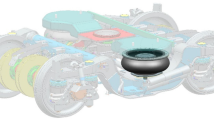Abstract
The Hydrodynamic ram (HRAM) phenomenon is one of the main types of ballistic battle damages of a military aircraft and has great importance to airframe survivability design. The HRAM phenomenon occurs in aircraft wing structures with internal fuel tanks. HRAM can generate approximately 690 bar (10000 psi) of pressure in the fuel tank. It causes significant damage to the wing fuel tank, which contains the fluid, and the connection structure of the wing fuel tank. The HRAM effect occurs due to the interaction between the fluid and structure, and damage can be investigated by measuring the pressure of the fluid and the dynamic strains on the structure. In this paper, a static test and an HRAM test of a composite T-joint were performed. The HRAM test utilized a ram simulator which can generate HRAM pressure. When a high speed cylindrical puck was fired to the ram simulator filled with water, HRAM pressure was generated, and the pressures of the fluid was measured. The failure behavior of the composite T-joint due to HRAM pressure was examined using the strain gauges and a PVDF sensor which were attached to the surface of the composite T-joint.
Similar content being viewed by others
References
G. J. Czarnecki, R. Hinrichsen and M. Maxson, Joint resistance to ram, 2005 US Air Force T&E Days, Nashville, Tennessee, Desember 6-8 (2005) 7647.
D. Varas, R. Zaera and J. Lopez-Puente, Experimental study of CFRP fluid-filled tubes subjected to high-velocity impact, Composite Structures, 93 (10) (2011) 2598–2609.
S. Heimbs, A. Mierzwa, T. Duwensee, C. Dreu, A. C. Nogueira, M. May, C. Less and J. Wolfrum, Investigation of static and dynamic failure behaviour of composite T-joints, IV ECCOMAS Thematic Conference on the Mechanical Response of Composites, University of Azores, Ponta Delgada, Azores, Portugal (2013).
S. Heimbs, T. Duwensee, A. C. Nogueira and J. Wolfrum, Hydrodynamic ram analysis of aircraft fuel tank with different composite T-joint designs, Structures Under Shock and Impact VIII (2014) 279–288.
G. J. Czarnecki and R. Hinrichsen, Assessment of dynamic skin-spar joint failure properties, 2007 US Air Force T&E Days, Destin, Florida (2007) 1672.
J. H. Kim and S. M. Jun, Battle damage analysis of aircraft wing fuel tanks by hydrodynamic ram effect, Journal of KSAS, 34 (4) (2006) 17–24.
Author information
Authors and Affiliations
Corresponding author
Additional information
Eun-Su Go is a Ph.D. student of Department of Aerospace Engineering, Chungnam National University, Daejeon, Republic of Korea. His research interests include impact behavior of composite materials, design and testing of composite structures, and thermalacoustic fatigue life prediction of aircraft structures.
In-Gul Kim is a Professor of Department of Aerospace Engineering, Chungnam National University, Daejeon, Republic of Korea. His research interests include impact behavior of composite materials, structural health monitoring, and design and testing of composite structures.
Rights and permissions
About this article
Cite this article
Go, ES., Kim, IG., Kim, DG. et al. Failure behavior of a composite T-joint subjected to hydrodynamic ram. J Mech Sci Technol 31, 4085–4091 (2017). https://doi.org/10.1007/s12206-017-0804-y
Received:
Revised:
Accepted:
Published:
Issue Date:
DOI: https://doi.org/10.1007/s12206-017-0804-y




